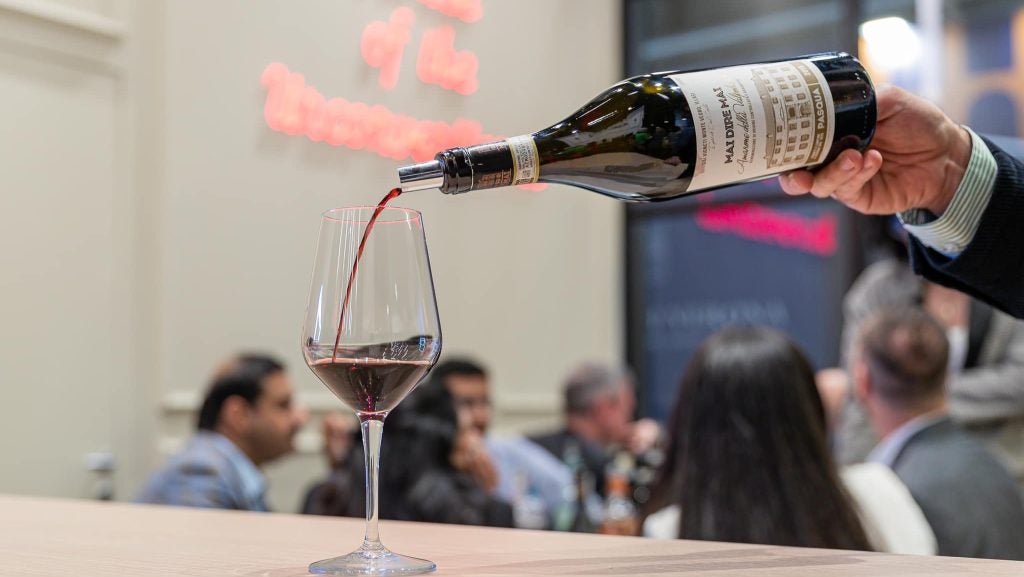
The wine industry faces a significant challenge: attracting a new generation of drinkers who have more choice in what they can consume, including not at all.
Family-owned Italian group Pasqua Wines does business in 70 markets, with exports generating 87% of its turnover (a turnover that in 2023 stood at €60.9m ($65.3m)).
The company was recently named Innovator of the Year by Wine Enthusiast magazine and, last month, announced a tie-up with the Saatchi Gallery in London, a move CEO Riccardo Pasqua said “underscores our cross-generational commitment to innovation, creativity and unconventional approaches”.
Speaking to Just Drinks, Mr. Pasqua sets out Pasqua’s growth expectations for 2024, supports calls for Italy to broaden its export base and argues the wine industry as a whole needs to do more to entice younger drinking-age demographics at a time of growing competition.
Just Drinks: Eighty-eight per cent of Pasqua’s business is exports. Where are your largest markets?
Riccardo Pasqua (RP): The United States is our first export market, accounting for one-third of export [sales]. In 2009, Pasqua was absolutely a ghost in the United States. We opened up Pasqua USA, our own importer, and since then we’ve had a beautiful journey of growth. I did it through the markets that are more open to these kinds of wines and to Italian imports, which are the two coasts first of all, starting from the East Coast.
Slowly but surely, we kept adding many other states to our portfolio, which is now around 47. Texas is our first [biggest] market.

US Tariffs are shifting - will you react or anticipate?
Don’t let policy changes catch you off guard. Stay proactive with real-time data and expert analysis.
By GlobalDataJD: Silicon Valley Bank estimated overall wine volume sales in the US were down 2-4% in 2023. How did Italian wine fare and did Pasqua manage to grow its volumes?
RP: 2023 was a year of adjustment. You’re talking shipments of all imports to the United States. Italy was down even worse, like, 7-8%. You have to factor in the hangover – allow me the term – from the pandemic. One thing is sell-in, one thing is depletions, or sell-out. The sell-in was tough. It was a very tough year for all imports, especially for Italy and France. The depletions, though, weren’t that bad. As an Italian system, the depletions were a little down but basically they were keeping their positions.
As far as Pasqua is concerned, the picture is very similar. As far as shipments, with the cost of money going up, all partners had to trim their inventories but depletions were not that bad. We were actually up a little bit, like, 3-4% up, and, in fact, the inventory effect is very elastic. The first quarter and the first four months of 2024 are very positive in the US in terms of sell-in.
JD: Is this volume rather than value? I wondered what impact any price increases could have had.
RP: No, this is value. We look only [at] value. Volume is worse than that. There were price increases over the past few years for sure, so volume is worse than that.
JD: What are you expecting for 2024 for Pasqua in the US?
RP: First of all, I wanted to close the circle and say that, looking at the US – and usually the US is kind of a benchmark [that] kind of downloads to other markets around the world – what we’re watching closely is the phenomenon of hard seltzers, mixology and other categories that are seducing the younger generation of consumers. This is not just an elastic effect of inventory going up and down. This is something that could be structural. I’ve not got a straight answer – we are seeing some categories, especially hard seltzer in the US going down pretty dramatically over the past few months – but we cannot ignore them. We need to be close as a wine brand, a winemaker, to the younger generation of consumers.
How? From winemaking style, all the way to how we communicate. All that said, Pasqua in the US is something like a little shy of 400,000 cases and we have a pretty bullish view in terms of growth in the United States because of a series of factors: new customers like Whole Foods [and] we have empowered even more Pasqua USA with a couple of very talented and experienced people. Even if almost five million bottles sound a lot, Pasqua is still relatively small in a market like the United States. Despite the fact we think the market in general is not that bullish, that is a little conservative. We still have a lot of room to grow and a lot of things to say, so we are envisioning a good year in the US. It’s also true that that is coming from a difficult 2023 but, even in depletions, we are looking to a good high-single-digit growth, let’s say.
Entry-level wines could be more at risk to competition from other categories
JD: What about volume?
RP: This year, 2024, we didn’t do any major price increases. The price list is an increase of 2%, something like that but there’s also the mix effect. We are working relentlessly – not only in the US, as a whole company – to promote and grow the top of the pyramid as far as our product strategy is concerned. Our projects [wine], first of all, can say a lot of things in that area and I believe that, in the future, the market will be even more polarised, with premium, ultra-premium and luxury wines that will always have a place in the tables everywhere in the world. The entry-level, in the meantime, could be more at risk, opening the competition to a series of other categories like mixology, hard seltzers, kombucha, craft beers.
JD: How can wine producers capture the interest of Gen Z, given the different options the younger demographic can drink, which also includes non-alcoholic products?
RP: Absolutely. We are approaching this issue, especially with the way we communicate. If you take a look at what we have done over the past few years, you will notice Pasqua has a pretty unique tone of voice in the wine business. We are really trying to educate and inform our consumers – and our prospective consumers – through entertainment, beauty, [and] lifestyle. Beauty and lifestyle, in our vision, in our projects, take the form mostly through arts and the 20-plus collaborations we’ve done over the past seven years. I know we’re not the first winery working with art but definitely we are the first to work with this kind of approach with this kind of art: something that is more immersive, something that tries to cast an eye towards a younger generation of consumer.

JD: Has the wine industry been too slow to embrace social media and, more broadly, to try to create brands compared to other types of beverages?
RP: For sure, 100%. Definitely, the spirits business and other categories did a better job, starting from packaging, to naming, to social media, to the collaboration with, you know, the music industry.
It’s a completely different game. Wine is a product with thousands of years of legacy, a product that the more diversity the better, especially in the Old World, especially in Italy, if you may. In Italy, we have 360-plus appellations and indigenous appellations but, in reality, they are much more than that. We have to protect this but that doesn’t exclude that we can approach the business – and that’s our credo – with a tone of voice, with a flair that tries to catch the attention also of the younger generation. Very often, the wine business, especially from the Old World, is a little self-celebrative, a little closed. That is a mistake.
JD: Does Pasqua have any no-or-low products in its portfolio?
RP: No, we are working to understand in depth the technology, the style, the approach we could have. We are not ignoring it. We think the technology is a little behind. We are working on really deeply understanding all the pieces of the puzzle. We will never have one of those products under Pasqua [and] Cecilia Beretta because [they] will keep going up there at the top of the pyramid but I don’t exclude that we can ever have a project in the future. We believe [no and low] is such a different story from everything else we’re doing and, as such, we will approach it as a completely different thing.
JD: What’s your overall view on consumer confidence in 2024?
RP: It’s not a secret the cost of money hurts and this is global. It’s not a secret that inflation over the past few years is hurting as well because prices are not back where they were. We see the numbers of the off-premise that are quite unmistakable because they go by scan data and, for sure, all the analysis is reporting that average spending is getting down. We are feeling even in our small world of a relatively small company that, after the hangover of the pandemic, people are more cautious.

JD: Lamberto Frescobaldi, the president of Italian winegrowers association the UIV, says the country needs to diversify its export base. How could the industry go about that?
RP: I couldn’t agree more. Take Asia, for example. China is dominated by France and Australia. Now, Australia has signed back the agreement with China. There is no reason why Italian wine shouldn’t be there at least as strong as France, meaning our red wines – because China is a 78% red wine drinker – from Veneto but also from Tuscany, also from Piedmont; even if they are a little more on the tannic side, they have the allure and the status that rich Chinese people [want].
JD: What has stopped Italy from capturing that opportunity?
RP: I think a sum of things. Timing. France started 40 years ago, pushing like hell. Logistics. Australia is very close and has had for many years a very good tax deal. And, honestly, what the French and Australians did better than us was go to the market very compact and united. Unfortunately, Italy went more on an opportunistic approach, which is a big mistake that we’re paying for.
To give you a number, France exports to China basically a very substantial value [of] over a €1bn, so why not? The market is difficult. Yes, they drink, I don’t know, one spoon of wine per capita a year but it is so big, so rich in certain areas. We need to keep pushing, educating, go there and demonstrate that Italian wines can give a great experience, that Italian wines can be a status as Made in Italy is in fashion, in automotive, in yachting, you name it. If we fix that, we answer Lamberto’s concern because China by itself can really equilibrate and balance the exposure we have towards the United States and other markets.



